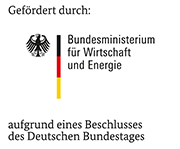18034 N

| Period: | 01.07.2014 - 30.09.2016 |
|---|---|
| Partner: | Institut für Mikroverfahrenstechnik (IMVT) am KIT |
| Funder: | AiF |
| Project Manager: | M.Sc. Thomas Traut |
| Research Group: | Corrosion |
Background and problems
The use of micro structured compounds in industrial chemical, pharmaceutical or food technology processes promises a considerable gain in substance and energy efficiency based on an excellent heat transfer due to larger surfaces as well as lower compound resistance inside micro channels. Thus, reactions are much faster and can be controlled better with a simultaneous improvement of selectivity. Furthermore, the resignation of solvents leads to a simpler product purifying and increases the process sustainability.
Micro process engineering methods are commonly interesting for those reactions using high aggressive chemical process media. Corrosion problems are serious handicaps for the wide industrial use of thin-walled (0.5 – 1.0 mm) micro channels.
Target
Aim of this research project is to establish an improved corrosion resistance for thin-walled, micro structured reactor compounds. Today, the corrosion resistance is not sufficient for many applications in the field of liquid phase reactions, due to the high corrosivity of process media with simultaneous intensified reaction conditions and minor material thickness.
Aim of project
To reach this aim, fundamental studies on the corrosion processes for typically used micro process engineering corrosion systems are carried out. On this, various electrochemical studies on two sulfuric acid resistant nickel-based superalloys Nicrofer 5621 hMoW (2.4602, Hastelloy C-22) and Nicrofer 5923 hMo (2.4605, Alloy 59), as well as two new developed high-alloy steels, Nicrofer 3426 hMo (Alloy 31 plus) and Nicrofer 5821 hMoN (Alloy 2120), will be accomplished under different conditions (condition of delivery, heat treated, diffusion welded, laser welded). The use of 70% sulfuric acid at a temperature of 85°C leads to a condition close to reality.
First results
At first, current density potential measurements on all four materials were performed at aforesaid conditions (figure 1). Material 2.4700 immediately passivates and therefore might be a good opportunity for building micro reactor compounds. Due to high corrosion rates of 2.4656 it is not qualified for this application. Materials 2.4602 and 2.4605 both show low corrosion rates and might be also not qualified.
Similar results show the sensitized samples (figure 2). The materials were treated in vacuum at 1100°C for 4 h.
Also the beaker corrosion tests at KIT show comparable results. So only materials 2.4700 and 2.4602 will be taken in account for further measurements.
Further approach
Impedance spectroscopic measurements and local corrosion measurements of laser welded seams are currently in progress.
With respect to corrosion prevention, the development of a protection concept using ultra-thin nano particle based enamel coatings for direct application into already welded micro reactor test compounds is aspired. In parallel, investigations on passive anodic protection with sputtered gold and tantalum coatings are carried out at the KIT. All coatings properties will be compared and intensively characterized (coating structure, chemical composition, corrosion performance).
back
Das IGF-Vorhaben Nr. 18034 N der Forschungsvereinigung DECHEMA e.V., Theodor-Heuss-Allee 25, 60486 Frankfurt am Main wurde über die AiF im Rahmen des Programms zur Förderung der industriellen Gemeinschaftsforschung (IGF) vom Bundesministerium für Wirtschaft und Energie aufgrund eines Beschlusses des Deutschen Bundestages gefördert.